Business Law Analysis: Sources, Business Impact & Dispute Resolutions
VerifiedAdded on 2023/06/13
|12
|3559
|316
Report
AI Summary
This report provides a comprehensive overview of business law in the United Kingdom. It details the primary and secondary sources of law, emphasizing the role of government in creating statutory and common law. The report illustrates the impact of company, employment, and contract laws on business operations, using specific examples. Furthermore, it discusses the formation, funding, and management of various business organizations, including sole proprietorships, partnerships, private limited companies, and public limited companies. The report concludes by suggesting appropriate legal solutions to resolve potential areas of dispute, offering practical guidance for businesses navigating the legal landscape. Desklib provides this and other solved assignments for students.
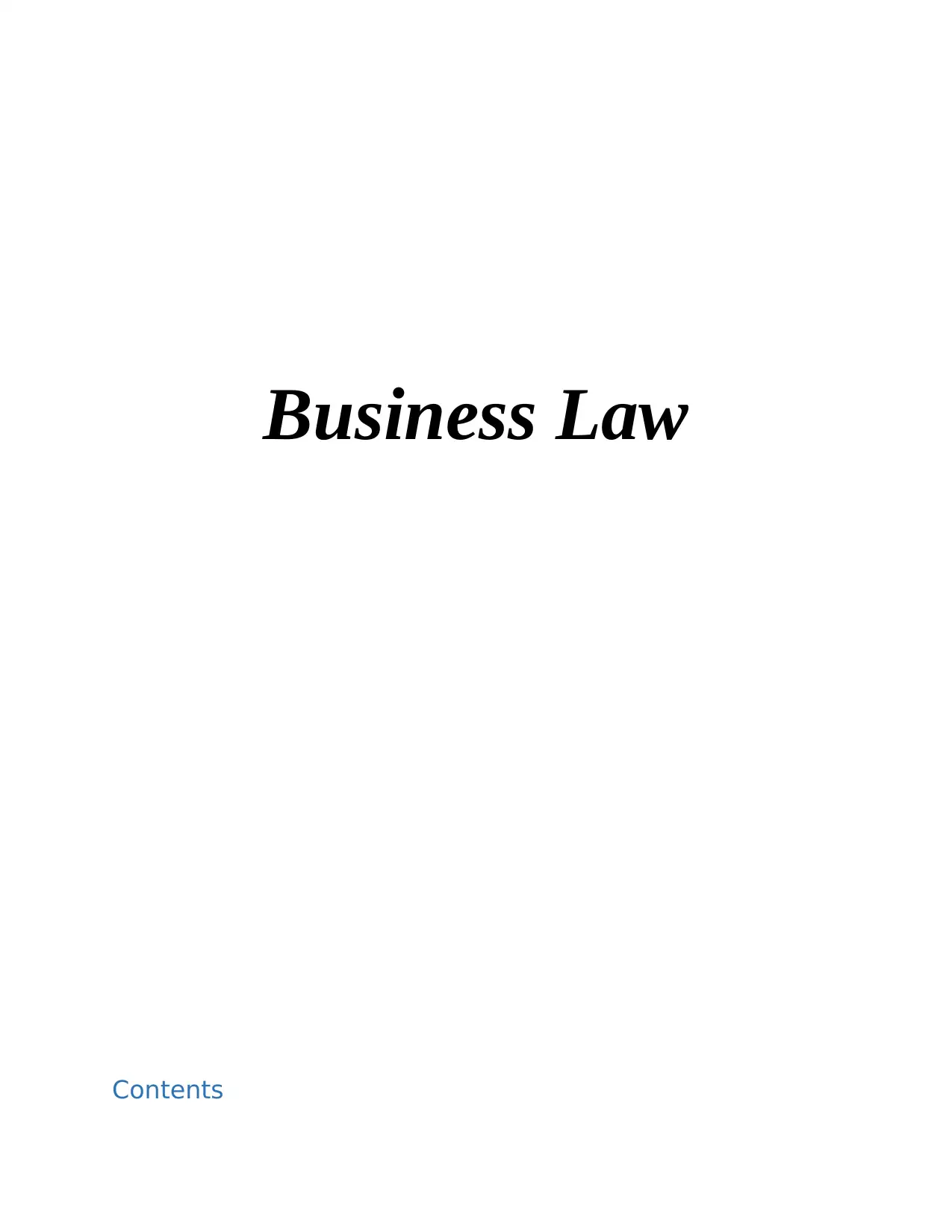
Business Law
Contents
Contents
Secure Best Marks with AI Grader
Need help grading? Try our AI Grader for instant feedback on your assignments.
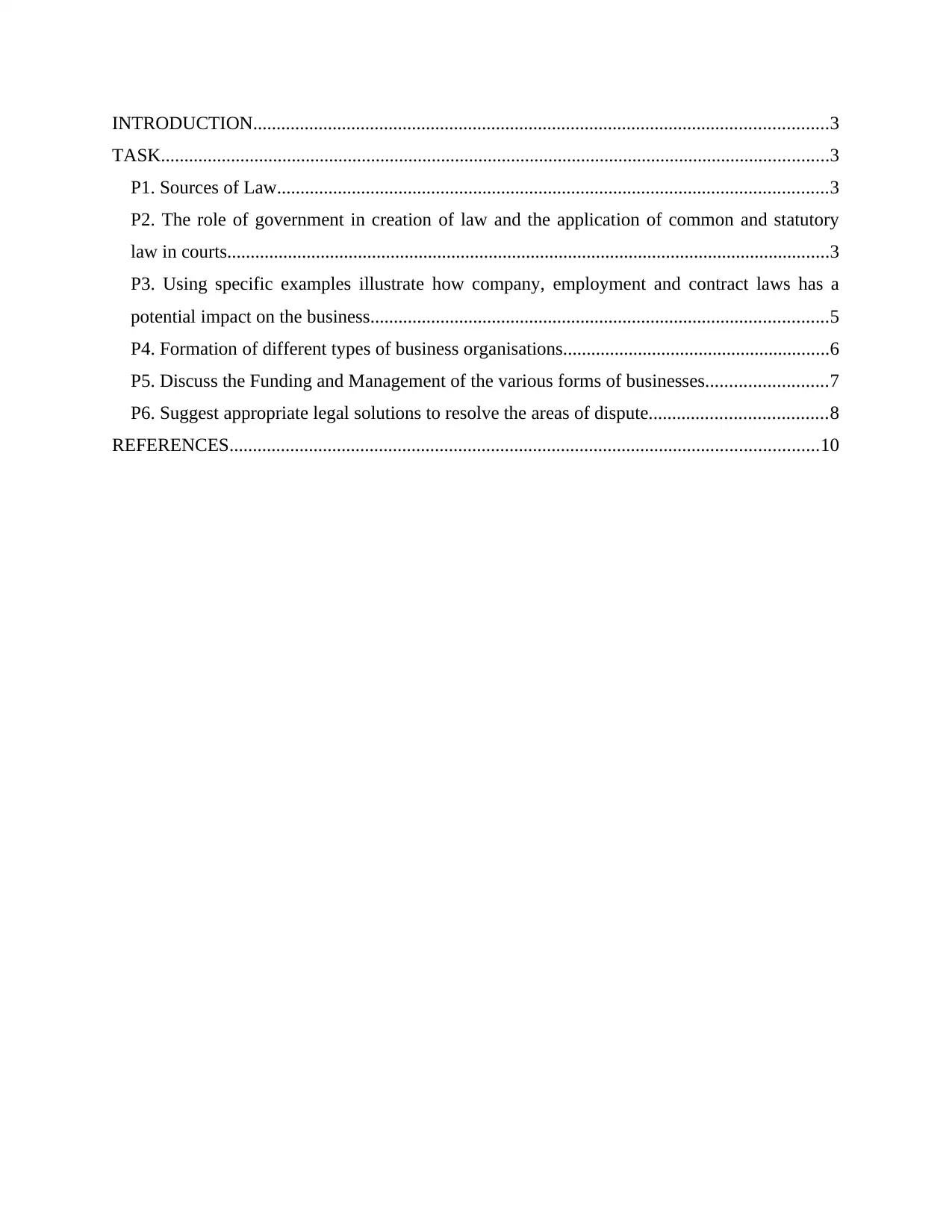
INTRODUCTION...........................................................................................................................3
TASK...............................................................................................................................................3
P1. Sources of Law......................................................................................................................3
P2. The role of government in creation of law and the application of common and statutory
law in courts.................................................................................................................................3
P3. Using specific examples illustrate how company, employment and contract laws has a
potential impact on the business..................................................................................................5
P4. Formation of different types of business organisations.........................................................6
P5. Discuss the Funding and Management of the various forms of businesses..........................7
P6. Suggest appropriate legal solutions to resolve the areas of dispute......................................8
REFERENCES..............................................................................................................................10
TASK...............................................................................................................................................3
P1. Sources of Law......................................................................................................................3
P2. The role of government in creation of law and the application of common and statutory
law in courts.................................................................................................................................3
P3. Using specific examples illustrate how company, employment and contract laws has a
potential impact on the business..................................................................................................5
P4. Formation of different types of business organisations.........................................................6
P5. Discuss the Funding and Management of the various forms of businesses..........................7
P6. Suggest appropriate legal solutions to resolve the areas of dispute......................................8
REFERENCES..............................................................................................................................10
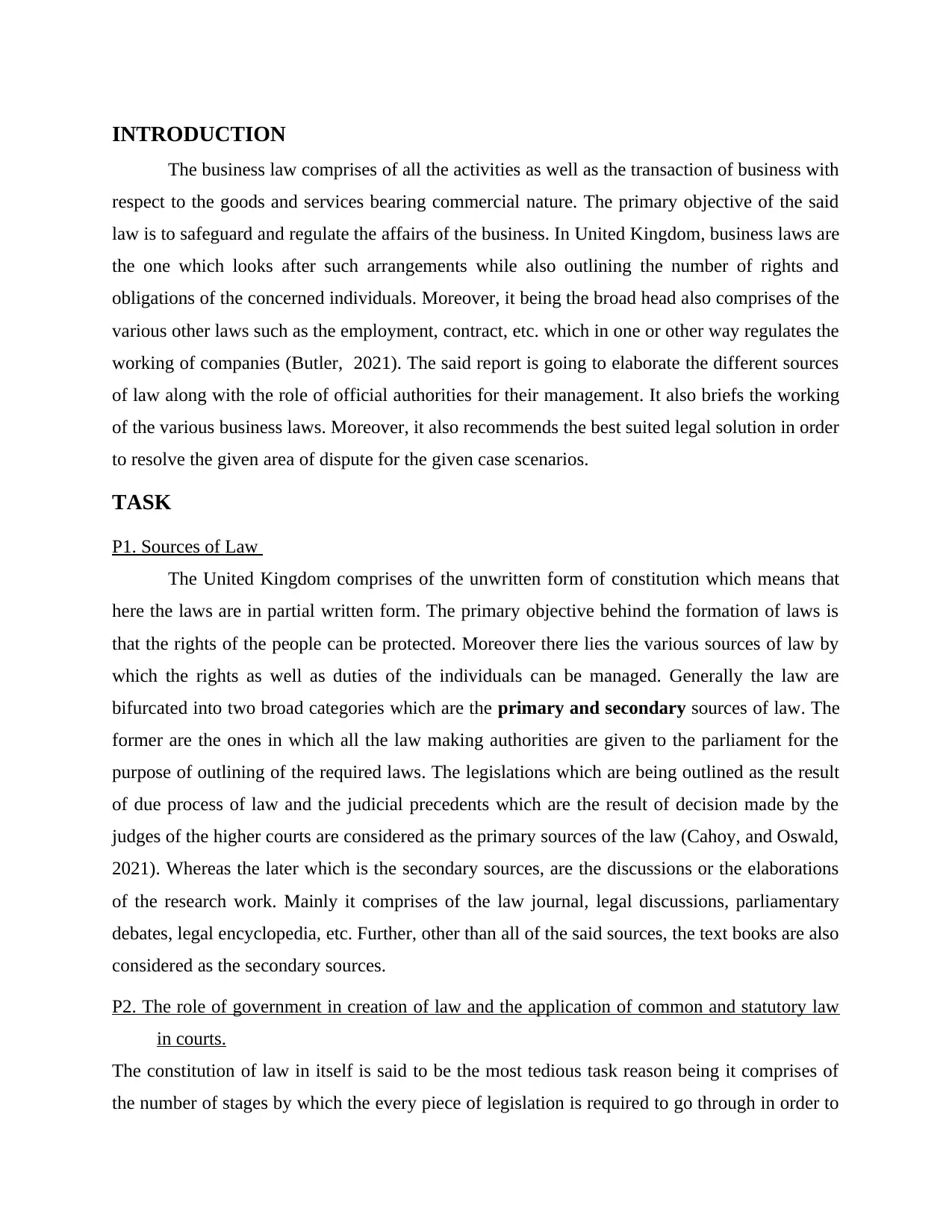
INTRODUCTION
The business law comprises of all the activities as well as the transaction of business with
respect to the goods and services bearing commercial nature. The primary objective of the said
law is to safeguard and regulate the affairs of the business. In United Kingdom, business laws are
the one which looks after such arrangements while also outlining the number of rights and
obligations of the concerned individuals. Moreover, it being the broad head also comprises of the
various other laws such as the employment, contract, etc. which in one or other way regulates the
working of companies (Butler, 2021). The said report is going to elaborate the different sources
of law along with the role of official authorities for their management. It also briefs the working
of the various business laws. Moreover, it also recommends the best suited legal solution in order
to resolve the given area of dispute for the given case scenarios.
TASK
P1. Sources of Law
The United Kingdom comprises of the unwritten form of constitution which means that
here the laws are in partial written form. The primary objective behind the formation of laws is
that the rights of the people can be protected. Moreover there lies the various sources of law by
which the rights as well as duties of the individuals can be managed. Generally the law are
bifurcated into two broad categories which are the primary and secondary sources of law. The
former are the ones in which all the law making authorities are given to the parliament for the
purpose of outlining of the required laws. The legislations which are being outlined as the result
of due process of law and the judicial precedents which are the result of decision made by the
judges of the higher courts are considered as the primary sources of the law (Cahoy, and Oswald,
2021). Whereas the later which is the secondary sources, are the discussions or the elaborations
of the research work. Mainly it comprises of the law journal, legal discussions, parliamentary
debates, legal encyclopedia, etc. Further, other than all of the said sources, the text books are also
considered as the secondary sources.
P2. The role of government in creation of law and the application of common and statutory law
in courts.
The constitution of law in itself is said to be the most tedious task reason being it comprises of
the number of stages by which the every piece of legislation is required to go through in order to
The business law comprises of all the activities as well as the transaction of business with
respect to the goods and services bearing commercial nature. The primary objective of the said
law is to safeguard and regulate the affairs of the business. In United Kingdom, business laws are
the one which looks after such arrangements while also outlining the number of rights and
obligations of the concerned individuals. Moreover, it being the broad head also comprises of the
various other laws such as the employment, contract, etc. which in one or other way regulates the
working of companies (Butler, 2021). The said report is going to elaborate the different sources
of law along with the role of official authorities for their management. It also briefs the working
of the various business laws. Moreover, it also recommends the best suited legal solution in order
to resolve the given area of dispute for the given case scenarios.
TASK
P1. Sources of Law
The United Kingdom comprises of the unwritten form of constitution which means that
here the laws are in partial written form. The primary objective behind the formation of laws is
that the rights of the people can be protected. Moreover there lies the various sources of law by
which the rights as well as duties of the individuals can be managed. Generally the law are
bifurcated into two broad categories which are the primary and secondary sources of law. The
former are the ones in which all the law making authorities are given to the parliament for the
purpose of outlining of the required laws. The legislations which are being outlined as the result
of due process of law and the judicial precedents which are the result of decision made by the
judges of the higher courts are considered as the primary sources of the law (Cahoy, and Oswald,
2021). Whereas the later which is the secondary sources, are the discussions or the elaborations
of the research work. Mainly it comprises of the law journal, legal discussions, parliamentary
debates, legal encyclopedia, etc. Further, other than all of the said sources, the text books are also
considered as the secondary sources.
P2. The role of government in creation of law and the application of common and statutory law
in courts.
The constitution of law in itself is said to be the most tedious task reason being it comprises of
the number of stages by which the every piece of legislation is required to go through in order to
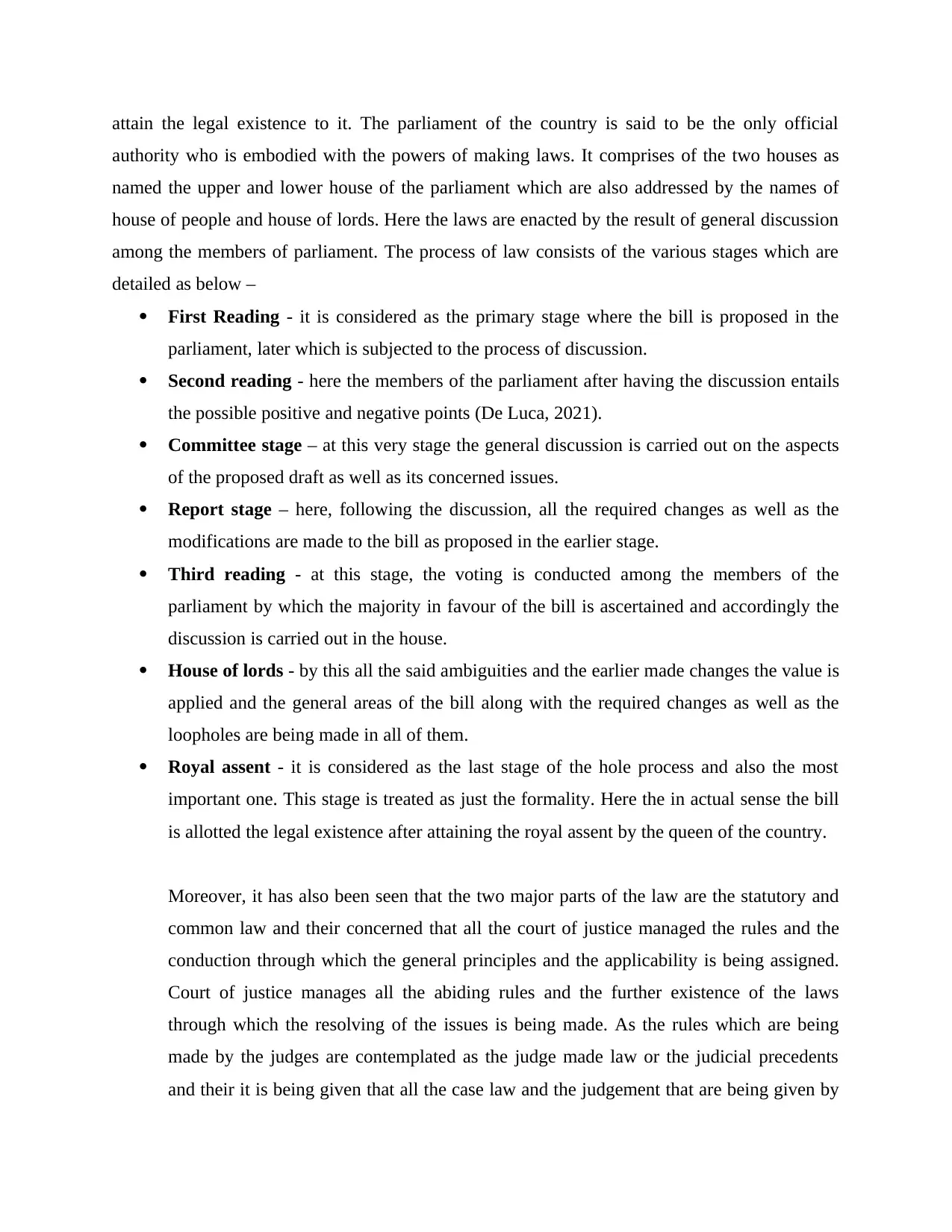
attain the legal existence to it. The parliament of the country is said to be the only official
authority who is embodied with the powers of making laws. It comprises of the two houses as
named the upper and lower house of the parliament which are also addressed by the names of
house of people and house of lords. Here the laws are enacted by the result of general discussion
among the members of parliament. The process of law consists of the various stages which are
detailed as below –
First Reading - it is considered as the primary stage where the bill is proposed in the
parliament, later which is subjected to the process of discussion.
Second reading - here the members of the parliament after having the discussion entails
the possible positive and negative points (De Luca, 2021).
Committee stage – at this very stage the general discussion is carried out on the aspects
of the proposed draft as well as its concerned issues.
Report stage – here, following the discussion, all the required changes as well as the
modifications are made to the bill as proposed in the earlier stage.
Third reading - at this stage, the voting is conducted among the members of the
parliament by which the majority in favour of the bill is ascertained and accordingly the
discussion is carried out in the house.
House of lords - by this all the said ambiguities and the earlier made changes the value is
applied and the general areas of the bill along with the required changes as well as the
loopholes are being made in all of them.
Royal assent - it is considered as the last stage of the hole process and also the most
important one. This stage is treated as just the formality. Here the in actual sense the bill
is allotted the legal existence after attaining the royal assent by the queen of the country.
Moreover, it has also been seen that the two major parts of the law are the statutory and
common law and their concerned that all the court of justice managed the rules and the
conduction through which the general principles and the applicability is being assigned.
Court of justice manages all the abiding rules and the further existence of the laws
through which the resolving of the issues is being made. As the rules which are being
made by the judges are contemplated as the judge made law or the judicial precedents
and their it is being given that all the case law and the judgement that are being given by
authority who is embodied with the powers of making laws. It comprises of the two houses as
named the upper and lower house of the parliament which are also addressed by the names of
house of people and house of lords. Here the laws are enacted by the result of general discussion
among the members of parliament. The process of law consists of the various stages which are
detailed as below –
First Reading - it is considered as the primary stage where the bill is proposed in the
parliament, later which is subjected to the process of discussion.
Second reading - here the members of the parliament after having the discussion entails
the possible positive and negative points (De Luca, 2021).
Committee stage – at this very stage the general discussion is carried out on the aspects
of the proposed draft as well as its concerned issues.
Report stage – here, following the discussion, all the required changes as well as the
modifications are made to the bill as proposed in the earlier stage.
Third reading - at this stage, the voting is conducted among the members of the
parliament by which the majority in favour of the bill is ascertained and accordingly the
discussion is carried out in the house.
House of lords - by this all the said ambiguities and the earlier made changes the value is
applied and the general areas of the bill along with the required changes as well as the
loopholes are being made in all of them.
Royal assent - it is considered as the last stage of the hole process and also the most
important one. This stage is treated as just the formality. Here the in actual sense the bill
is allotted the legal existence after attaining the royal assent by the queen of the country.
Moreover, it has also been seen that the two major parts of the law are the statutory and
common law and their concerned that all the court of justice managed the rules and the
conduction through which the general principles and the applicability is being assigned.
Court of justice manages all the abiding rules and the further existence of the laws
through which the resolving of the issues is being made. As the rules which are being
made by the judges are contemplated as the judge made law or the judicial precedents
and their it is being given that all the case law and the judgement that are being given by
Secure Best Marks with AI Grader
Need help grading? Try our AI Grader for instant feedback on your assignments.
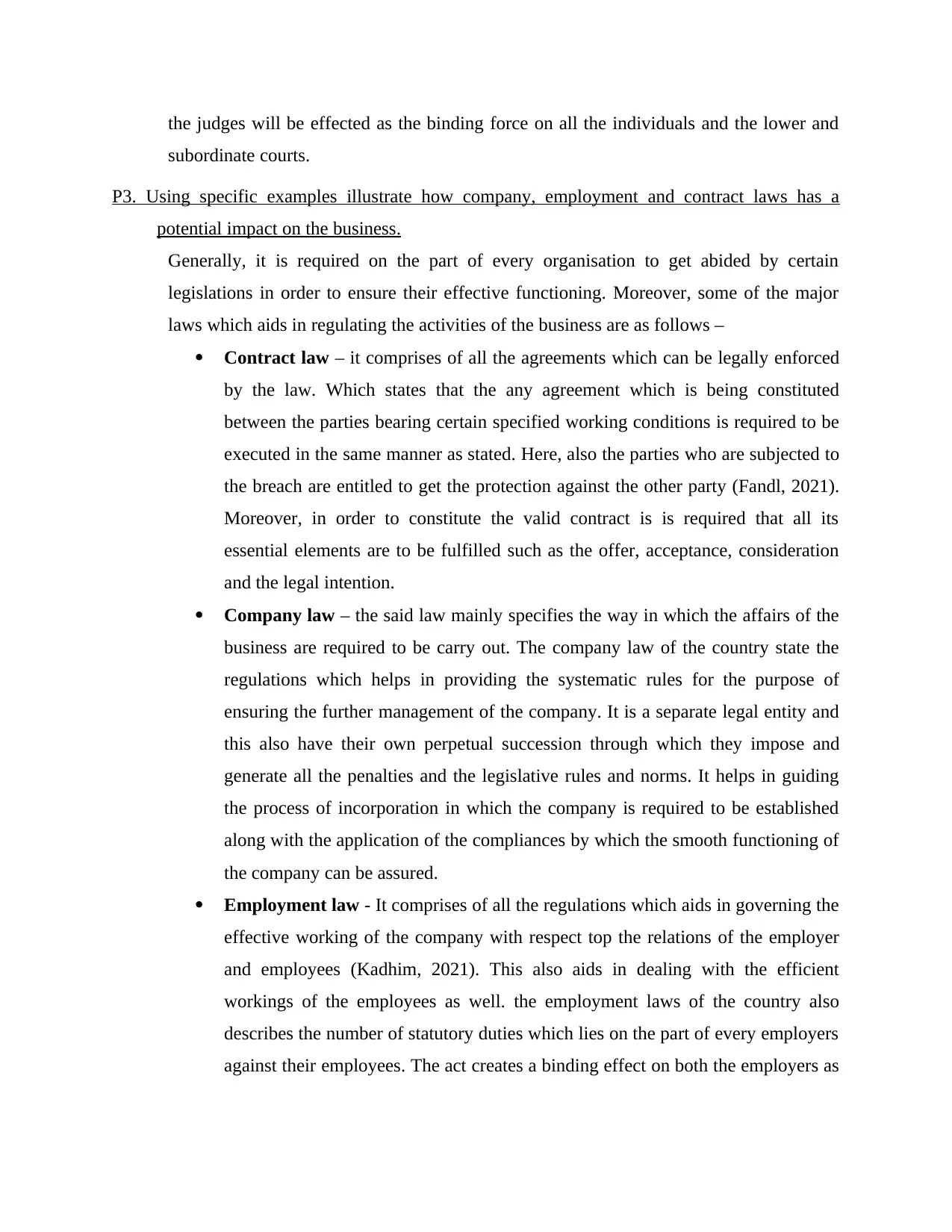
the judges will be effected as the binding force on all the individuals and the lower and
subordinate courts.
P3. Using specific examples illustrate how company, employment and contract laws has a
potential impact on the business.
Generally, it is required on the part of every organisation to get abided by certain
legislations in order to ensure their effective functioning. Moreover, some of the major
laws which aids in regulating the activities of the business are as follows –
Contract law – it comprises of all the agreements which can be legally enforced
by the law. Which states that the any agreement which is being constituted
between the parties bearing certain specified working conditions is required to be
executed in the same manner as stated. Here, also the parties who are subjected to
the breach are entitled to get the protection against the other party (Fandl, 2021).
Moreover, in order to constitute the valid contract is is required that all its
essential elements are to be fulfilled such as the offer, acceptance, consideration
and the legal intention.
Company law – the said law mainly specifies the way in which the affairs of the
business are required to be carry out. The company law of the country state the
regulations which helps in providing the systematic rules for the purpose of
ensuring the further management of the company. It is a separate legal entity and
this also have their own perpetual succession through which they impose and
generate all the penalties and the legislative rules and norms. It helps in guiding
the process of incorporation in which the company is required to be established
along with the application of the compliances by which the smooth functioning of
the company can be assured.
Employment law - It comprises of all the regulations which aids in governing the
effective working of the company with respect top the relations of the employer
and employees (Kadhim, 2021). This also aids in dealing with the efficient
workings of the employees as well. the employment laws of the country also
describes the number of statutory duties which lies on the part of every employers
against their employees. The act creates a binding effect on both the employers as
subordinate courts.
P3. Using specific examples illustrate how company, employment and contract laws has a
potential impact on the business.
Generally, it is required on the part of every organisation to get abided by certain
legislations in order to ensure their effective functioning. Moreover, some of the major
laws which aids in regulating the activities of the business are as follows –
Contract law – it comprises of all the agreements which can be legally enforced
by the law. Which states that the any agreement which is being constituted
between the parties bearing certain specified working conditions is required to be
executed in the same manner as stated. Here, also the parties who are subjected to
the breach are entitled to get the protection against the other party (Fandl, 2021).
Moreover, in order to constitute the valid contract is is required that all its
essential elements are to be fulfilled such as the offer, acceptance, consideration
and the legal intention.
Company law – the said law mainly specifies the way in which the affairs of the
business are required to be carry out. The company law of the country state the
regulations which helps in providing the systematic rules for the purpose of
ensuring the further management of the company. It is a separate legal entity and
this also have their own perpetual succession through which they impose and
generate all the penalties and the legislative rules and norms. It helps in guiding
the process of incorporation in which the company is required to be established
along with the application of the compliances by which the smooth functioning of
the company can be assured.
Employment law - It comprises of all the regulations which aids in governing the
effective working of the company with respect top the relations of the employer
and employees (Kadhim, 2021). This also aids in dealing with the efficient
workings of the employees as well. the employment laws of the country also
describes the number of statutory duties which lies on the part of every employers
against their employees. The act creates a binding effect on both the employers as
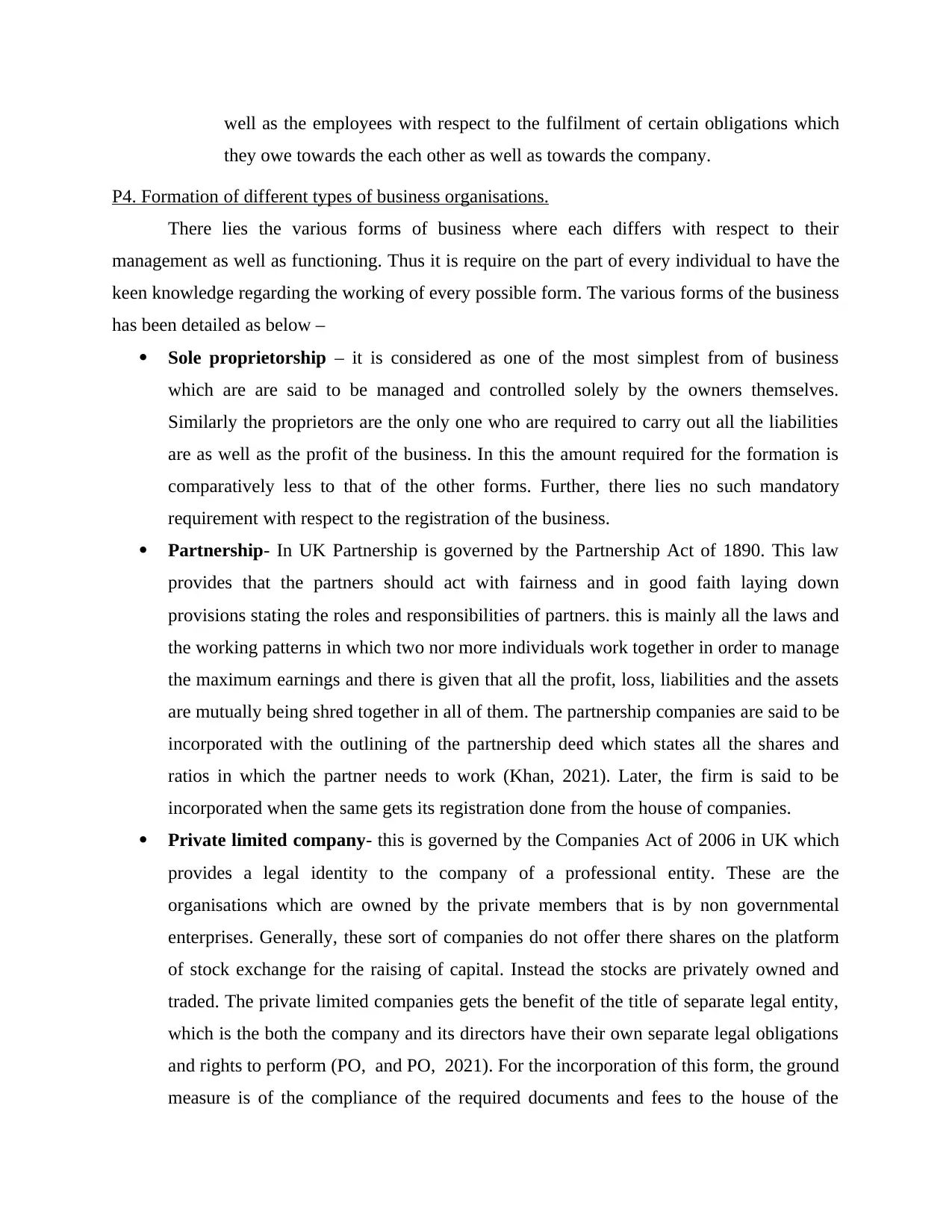
well as the employees with respect to the fulfilment of certain obligations which
they owe towards the each other as well as towards the company.
P4. Formation of different types of business organisations.
There lies the various forms of business where each differs with respect to their
management as well as functioning. Thus it is require on the part of every individual to have the
keen knowledge regarding the working of every possible form. The various forms of the business
has been detailed as below –
Sole proprietorship – it is considered as one of the most simplest from of business
which are are said to be managed and controlled solely by the owners themselves.
Similarly the proprietors are the only one who are required to carry out all the liabilities
are as well as the profit of the business. In this the amount required for the formation is
comparatively less to that of the other forms. Further, there lies no such mandatory
requirement with respect to the registration of the business.
Partnership- In UK Partnership is governed by the Partnership Act of 1890. This law
provides that the partners should act with fairness and in good faith laying down
provisions stating the roles and responsibilities of partners. this is mainly all the laws and
the working patterns in which two nor more individuals work together in order to manage
the maximum earnings and there is given that all the profit, loss, liabilities and the assets
are mutually being shred together in all of them. The partnership companies are said to be
incorporated with the outlining of the partnership deed which states all the shares and
ratios in which the partner needs to work (Khan, 2021). Later, the firm is said to be
incorporated when the same gets its registration done from the house of companies.
Private limited company- this is governed by the Companies Act of 2006 in UK which
provides a legal identity to the company of a professional entity. These are the
organisations which are owned by the private members that is by non governmental
enterprises. Generally, these sort of companies do not offer there shares on the platform
of stock exchange for the raising of capital. Instead the stocks are privately owned and
traded. The private limited companies gets the benefit of the title of separate legal entity,
which is the both the company and its directors have their own separate legal obligations
and rights to perform (PO, and PO, 2021). For the incorporation of this form, the ground
measure is of the compliance of the required documents and fees to the house of the
they owe towards the each other as well as towards the company.
P4. Formation of different types of business organisations.
There lies the various forms of business where each differs with respect to their
management as well as functioning. Thus it is require on the part of every individual to have the
keen knowledge regarding the working of every possible form. The various forms of the business
has been detailed as below –
Sole proprietorship – it is considered as one of the most simplest from of business
which are are said to be managed and controlled solely by the owners themselves.
Similarly the proprietors are the only one who are required to carry out all the liabilities
are as well as the profit of the business. In this the amount required for the formation is
comparatively less to that of the other forms. Further, there lies no such mandatory
requirement with respect to the registration of the business.
Partnership- In UK Partnership is governed by the Partnership Act of 1890. This law
provides that the partners should act with fairness and in good faith laying down
provisions stating the roles and responsibilities of partners. this is mainly all the laws and
the working patterns in which two nor more individuals work together in order to manage
the maximum earnings and there is given that all the profit, loss, liabilities and the assets
are mutually being shred together in all of them. The partnership companies are said to be
incorporated with the outlining of the partnership deed which states all the shares and
ratios in which the partner needs to work (Khan, 2021). Later, the firm is said to be
incorporated when the same gets its registration done from the house of companies.
Private limited company- this is governed by the Companies Act of 2006 in UK which
provides a legal identity to the company of a professional entity. These are the
organisations which are owned by the private members that is by non governmental
enterprises. Generally, these sort of companies do not offer there shares on the platform
of stock exchange for the raising of capital. Instead the stocks are privately owned and
traded. The private limited companies gets the benefit of the title of separate legal entity,
which is the both the company and its directors have their own separate legal obligations
and rights to perform (PO, and PO, 2021). For the incorporation of this form, the ground
measure is of the compliance of the required documents and fees to the house of the
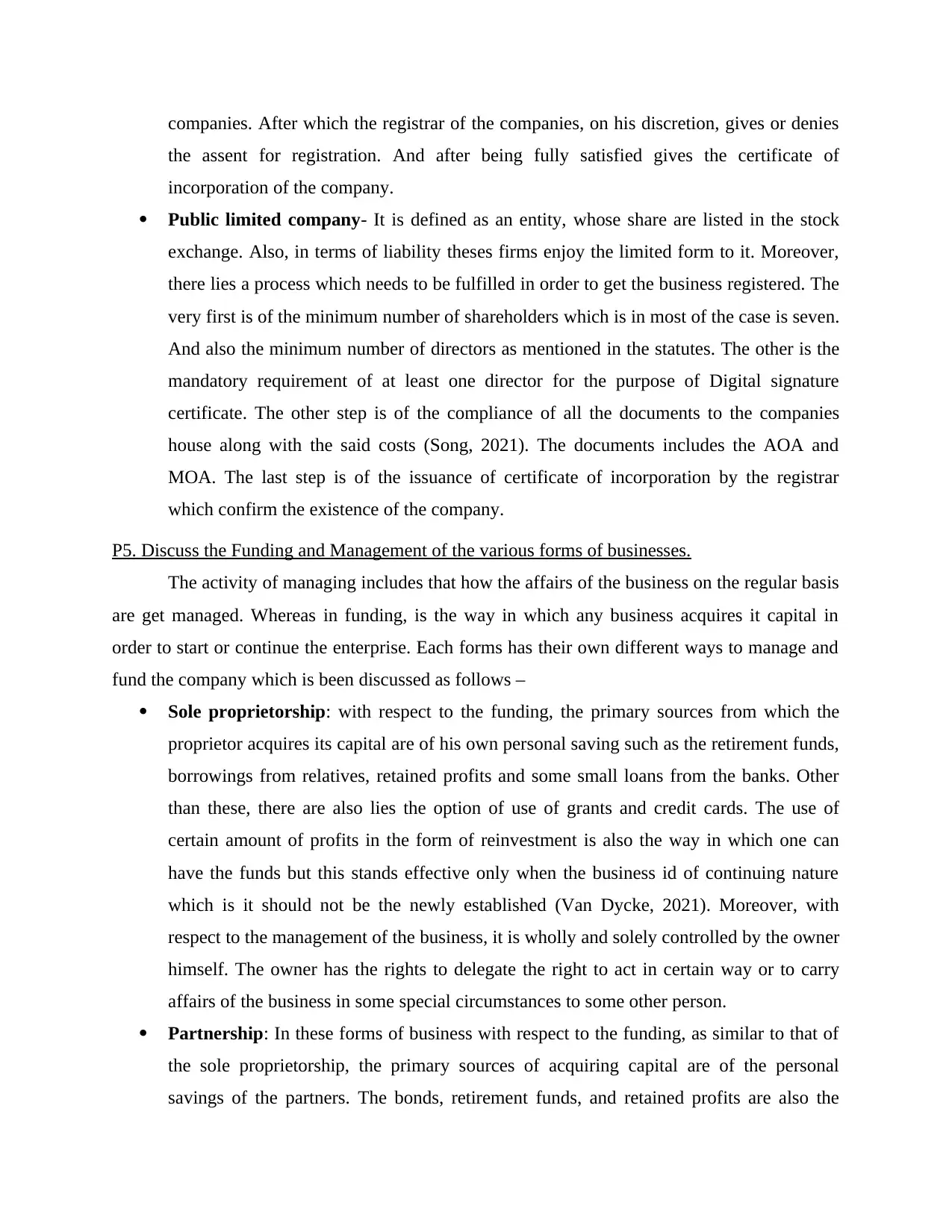
companies. After which the registrar of the companies, on his discretion, gives or denies
the assent for registration. And after being fully satisfied gives the certificate of
incorporation of the company.
Public limited company- It is defined as an entity, whose share are listed in the stock
exchange. Also, in terms of liability theses firms enjoy the limited form to it. Moreover,
there lies a process which needs to be fulfilled in order to get the business registered. The
very first is of the minimum number of shareholders which is in most of the case is seven.
And also the minimum number of directors as mentioned in the statutes. The other is the
mandatory requirement of at least one director for the purpose of Digital signature
certificate. The other step is of the compliance of all the documents to the companies
house along with the said costs (Song, 2021). The documents includes the AOA and
MOA. The last step is of the issuance of certificate of incorporation by the registrar
which confirm the existence of the company.
P5. Discuss the Funding and Management of the various forms of businesses.
The activity of managing includes that how the affairs of the business on the regular basis
are get managed. Whereas in funding, is the way in which any business acquires it capital in
order to start or continue the enterprise. Each forms has their own different ways to manage and
fund the company which is been discussed as follows –
Sole proprietorship: with respect to the funding, the primary sources from which the
proprietor acquires its capital are of his own personal saving such as the retirement funds,
borrowings from relatives, retained profits and some small loans from the banks. Other
than these, there are also lies the option of use of grants and credit cards. The use of
certain amount of profits in the form of reinvestment is also the way in which one can
have the funds but this stands effective only when the business id of continuing nature
which is it should not be the newly established (Van Dycke, 2021). Moreover, with
respect to the management of the business, it is wholly and solely controlled by the owner
himself. The owner has the rights to delegate the right to act in certain way or to carry
affairs of the business in some special circumstances to some other person.
Partnership: In these forms of business with respect to the funding, as similar to that of
the sole proprietorship, the primary sources of acquiring capital are of the personal
savings of the partners. The bonds, retirement funds, and retained profits are also the
the assent for registration. And after being fully satisfied gives the certificate of
incorporation of the company.
Public limited company- It is defined as an entity, whose share are listed in the stock
exchange. Also, in terms of liability theses firms enjoy the limited form to it. Moreover,
there lies a process which needs to be fulfilled in order to get the business registered. The
very first is of the minimum number of shareholders which is in most of the case is seven.
And also the minimum number of directors as mentioned in the statutes. The other is the
mandatory requirement of at least one director for the purpose of Digital signature
certificate. The other step is of the compliance of all the documents to the companies
house along with the said costs (Song, 2021). The documents includes the AOA and
MOA. The last step is of the issuance of certificate of incorporation by the registrar
which confirm the existence of the company.
P5. Discuss the Funding and Management of the various forms of businesses.
The activity of managing includes that how the affairs of the business on the regular basis
are get managed. Whereas in funding, is the way in which any business acquires it capital in
order to start or continue the enterprise. Each forms has their own different ways to manage and
fund the company which is been discussed as follows –
Sole proprietorship: with respect to the funding, the primary sources from which the
proprietor acquires its capital are of his own personal saving such as the retirement funds,
borrowings from relatives, retained profits and some small loans from the banks. Other
than these, there are also lies the option of use of grants and credit cards. The use of
certain amount of profits in the form of reinvestment is also the way in which one can
have the funds but this stands effective only when the business id of continuing nature
which is it should not be the newly established (Van Dycke, 2021). Moreover, with
respect to the management of the business, it is wholly and solely controlled by the owner
himself. The owner has the rights to delegate the right to act in certain way or to carry
affairs of the business in some special circumstances to some other person.
Partnership: In these forms of business with respect to the funding, as similar to that of
the sole proprietorship, the primary sources of acquiring capital are of the personal
savings of the partners. The bonds, retirement funds, and retained profits are also the
Paraphrase This Document
Need a fresh take? Get an instant paraphrase of this document with our AI Paraphraser
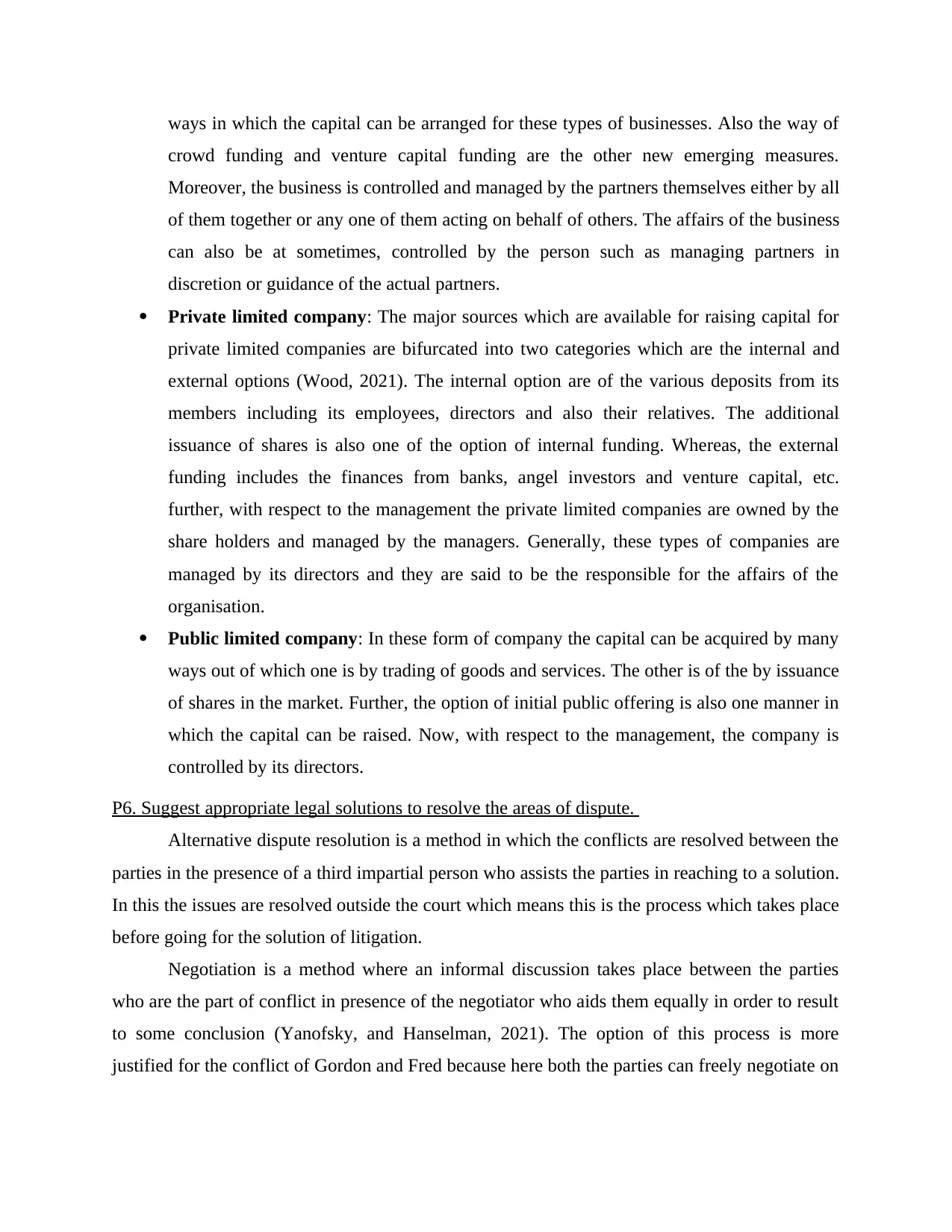
ways in which the capital can be arranged for these types of businesses. Also the way of
crowd funding and venture capital funding are the other new emerging measures.
Moreover, the business is controlled and managed by the partners themselves either by all
of them together or any one of them acting on behalf of others. The affairs of the business
can also be at sometimes, controlled by the person such as managing partners in
discretion or guidance of the actual partners.
Private limited company: The major sources which are available for raising capital for
private limited companies are bifurcated into two categories which are the internal and
external options (Wood, 2021). The internal option are of the various deposits from its
members including its employees, directors and also their relatives. The additional
issuance of shares is also one of the option of internal funding. Whereas, the external
funding includes the finances from banks, angel investors and venture capital, etc.
further, with respect to the management the private limited companies are owned by the
share holders and managed by the managers. Generally, these types of companies are
managed by its directors and they are said to be the responsible for the affairs of the
organisation.
Public limited company: In these form of company the capital can be acquired by many
ways out of which one is by trading of goods and services. The other is of the by issuance
of shares in the market. Further, the option of initial public offering is also one manner in
which the capital can be raised. Now, with respect to the management, the company is
controlled by its directors.
P6. Suggest appropriate legal solutions to resolve the areas of dispute.
Alternative dispute resolution is a method in which the conflicts are resolved between the
parties in the presence of a third impartial person who assists the parties in reaching to a solution.
In this the issues are resolved outside the court which means this is the process which takes place
before going for the solution of litigation.
Negotiation is a method where an informal discussion takes place between the parties
who are the part of conflict in presence of the negotiator who aids them equally in order to result
to some conclusion (Yanofsky, and Hanselman, 2021). The option of this process is more
justified for the conflict of Gordon and Fred because here both the parties can freely negotiate on
crowd funding and venture capital funding are the other new emerging measures.
Moreover, the business is controlled and managed by the partners themselves either by all
of them together or any one of them acting on behalf of others. The affairs of the business
can also be at sometimes, controlled by the person such as managing partners in
discretion or guidance of the actual partners.
Private limited company: The major sources which are available for raising capital for
private limited companies are bifurcated into two categories which are the internal and
external options (Wood, 2021). The internal option are of the various deposits from its
members including its employees, directors and also their relatives. The additional
issuance of shares is also one of the option of internal funding. Whereas, the external
funding includes the finances from banks, angel investors and venture capital, etc.
further, with respect to the management the private limited companies are owned by the
share holders and managed by the managers. Generally, these types of companies are
managed by its directors and they are said to be the responsible for the affairs of the
organisation.
Public limited company: In these form of company the capital can be acquired by many
ways out of which one is by trading of goods and services. The other is of the by issuance
of shares in the market. Further, the option of initial public offering is also one manner in
which the capital can be raised. Now, with respect to the management, the company is
controlled by its directors.
P6. Suggest appropriate legal solutions to resolve the areas of dispute.
Alternative dispute resolution is a method in which the conflicts are resolved between the
parties in the presence of a third impartial person who assists the parties in reaching to a solution.
In this the issues are resolved outside the court which means this is the process which takes place
before going for the solution of litigation.
Negotiation is a method where an informal discussion takes place between the parties
who are the part of conflict in presence of the negotiator who aids them equally in order to result
to some conclusion (Yanofsky, and Hanselman, 2021). The option of this process is more
justified for the conflict of Gordon and Fred because here both the parties can freely negotiate on
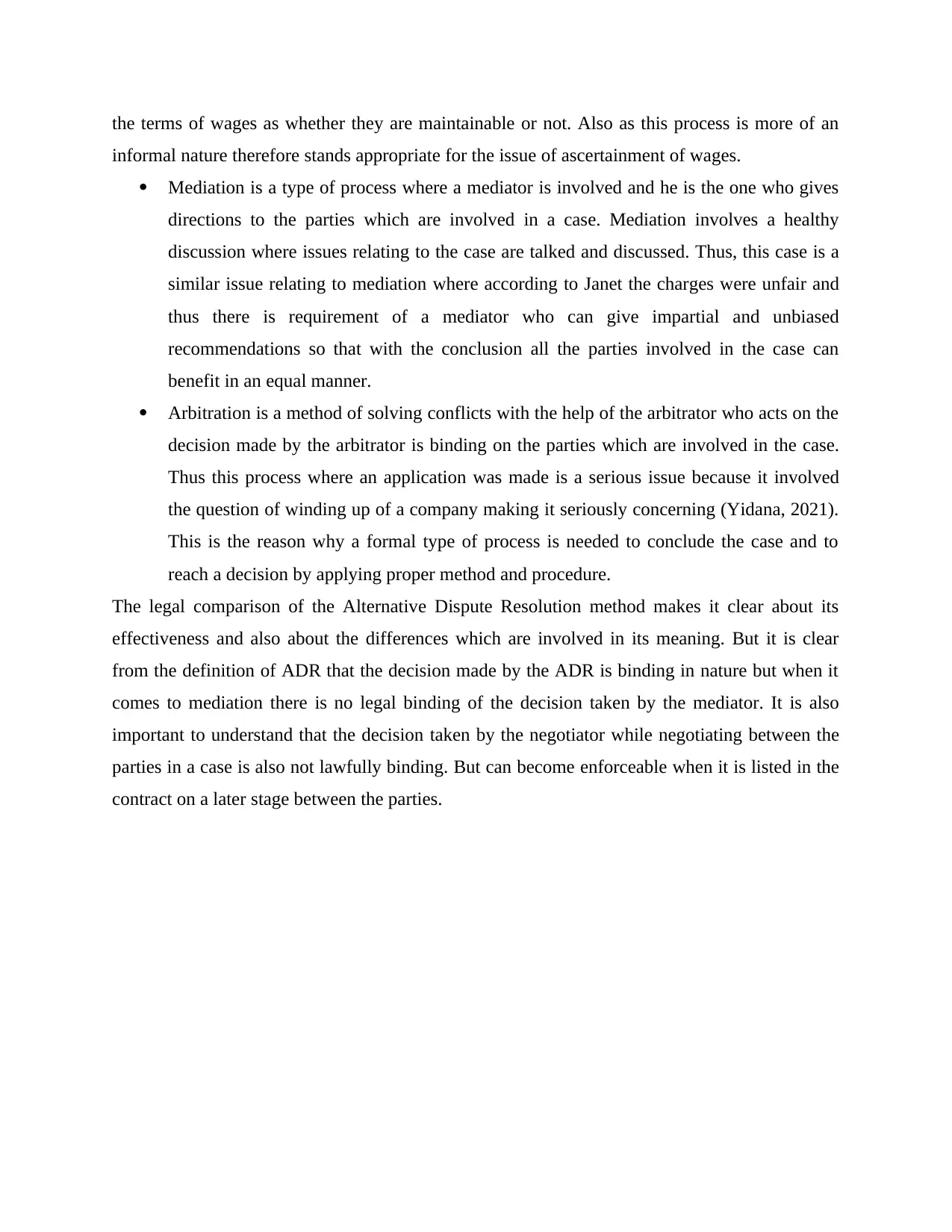
the terms of wages as whether they are maintainable or not. Also as this process is more of an
informal nature therefore stands appropriate for the issue of ascertainment of wages.
Mediation is a type of process where a mediator is involved and he is the one who gives
directions to the parties which are involved in a case. Mediation involves a healthy
discussion where issues relating to the case are talked and discussed. Thus, this case is a
similar issue relating to mediation where according to Janet the charges were unfair and
thus there is requirement of a mediator who can give impartial and unbiased
recommendations so that with the conclusion all the parties involved in the case can
benefit in an equal manner.
Arbitration is a method of solving conflicts with the help of the arbitrator who acts on the
decision made by the arbitrator is binding on the parties which are involved in the case.
Thus this process where an application was made is a serious issue because it involved
the question of winding up of a company making it seriously concerning (Yidana, 2021).
This is the reason why a formal type of process is needed to conclude the case and to
reach a decision by applying proper method and procedure.
The legal comparison of the Alternative Dispute Resolution method makes it clear about its
effectiveness and also about the differences which are involved in its meaning. But it is clear
from the definition of ADR that the decision made by the ADR is binding in nature but when it
comes to mediation there is no legal binding of the decision taken by the mediator. It is also
important to understand that the decision taken by the negotiator while negotiating between the
parties in a case is also not lawfully binding. But can become enforceable when it is listed in the
contract on a later stage between the parties.
informal nature therefore stands appropriate for the issue of ascertainment of wages.
Mediation is a type of process where a mediator is involved and he is the one who gives
directions to the parties which are involved in a case. Mediation involves a healthy
discussion where issues relating to the case are talked and discussed. Thus, this case is a
similar issue relating to mediation where according to Janet the charges were unfair and
thus there is requirement of a mediator who can give impartial and unbiased
recommendations so that with the conclusion all the parties involved in the case can
benefit in an equal manner.
Arbitration is a method of solving conflicts with the help of the arbitrator who acts on the
decision made by the arbitrator is binding on the parties which are involved in the case.
Thus this process where an application was made is a serious issue because it involved
the question of winding up of a company making it seriously concerning (Yidana, 2021).
This is the reason why a formal type of process is needed to conclude the case and to
reach a decision by applying proper method and procedure.
The legal comparison of the Alternative Dispute Resolution method makes it clear about its
effectiveness and also about the differences which are involved in its meaning. But it is clear
from the definition of ADR that the decision made by the ADR is binding in nature but when it
comes to mediation there is no legal binding of the decision taken by the mediator. It is also
important to understand that the decision taken by the negotiator while negotiating between the
parties in a case is also not lawfully binding. But can become enforceable when it is listed in the
contract on a later stage between the parties.
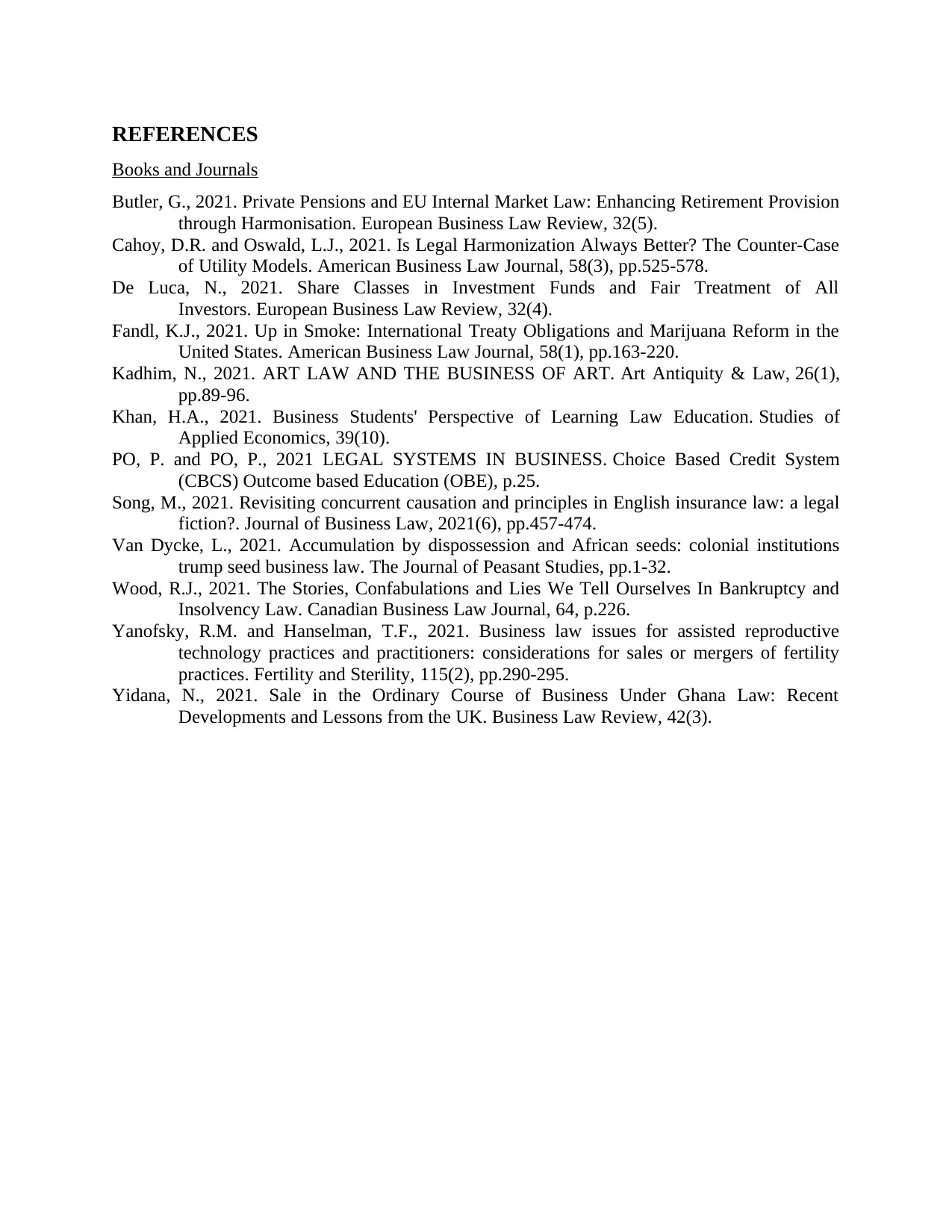
REFERENCES
Books and Journals
Butler, G., 2021. Private Pensions and EU Internal Market Law: Enhancing Retirement Provision
through Harmonisation. European Business Law Review, 32(5).
Cahoy, D.R. and Oswald, L.J., 2021. Is Legal Harmonization Always Better? The Counter‐Case
of Utility Models. American Business Law Journal, 58(3), pp.525-578.
De Luca, N., 2021. Share Classes in Investment Funds and Fair Treatment of All
Investors. European Business Law Review, 32(4).
Fandl, K.J., 2021. Up in Smoke: International Treaty Obligations and Marijuana Reform in the
United States. American Business Law Journal, 58(1), pp.163-220.
Kadhim, N., 2021. ART LAW AND THE BUSINESS OF ART. Art Antiquity & Law, 26(1),
pp.89-96.
Khan, H.A., 2021. Business Students' Perspective of Learning Law Education. Studies of
Applied Economics, 39(10).
PO, P. and PO, P., 2021 LEGAL SYSTEMS IN BUSINESS. Choice Based Credit System
(CBCS) Outcome based Education (OBE), p.25.
Song, M., 2021. Revisiting concurrent causation and principles in English insurance law: a legal
fiction?. Journal of Business Law, 2021(6), pp.457-474.
Van Dycke, L., 2021. Accumulation by dispossession and African seeds: colonial institutions
trump seed business law. The Journal of Peasant Studies, pp.1-32.
Wood, R.J., 2021. The Stories, Confabulations and Lies We Tell Ourselves In Bankruptcy and
Insolvency Law. Canadian Business Law Journal, 64, p.226.
Yanofsky, R.M. and Hanselman, T.F., 2021. Business law issues for assisted reproductive
technology practices and practitioners: considerations for sales or mergers of fertility
practices. Fertility and Sterility, 115(2), pp.290-295.
Yidana, N., 2021. Sale in the Ordinary Course of Business Under Ghana Law: Recent
Developments and Lessons from the UK. Business Law Review, 42(3).
Books and Journals
Butler, G., 2021. Private Pensions and EU Internal Market Law: Enhancing Retirement Provision
through Harmonisation. European Business Law Review, 32(5).
Cahoy, D.R. and Oswald, L.J., 2021. Is Legal Harmonization Always Better? The Counter‐Case
of Utility Models. American Business Law Journal, 58(3), pp.525-578.
De Luca, N., 2021. Share Classes in Investment Funds and Fair Treatment of All
Investors. European Business Law Review, 32(4).
Fandl, K.J., 2021. Up in Smoke: International Treaty Obligations and Marijuana Reform in the
United States. American Business Law Journal, 58(1), pp.163-220.
Kadhim, N., 2021. ART LAW AND THE BUSINESS OF ART. Art Antiquity & Law, 26(1),
pp.89-96.
Khan, H.A., 2021. Business Students' Perspective of Learning Law Education. Studies of
Applied Economics, 39(10).
PO, P. and PO, P., 2021 LEGAL SYSTEMS IN BUSINESS. Choice Based Credit System
(CBCS) Outcome based Education (OBE), p.25.
Song, M., 2021. Revisiting concurrent causation and principles in English insurance law: a legal
fiction?. Journal of Business Law, 2021(6), pp.457-474.
Van Dycke, L., 2021. Accumulation by dispossession and African seeds: colonial institutions
trump seed business law. The Journal of Peasant Studies, pp.1-32.
Wood, R.J., 2021. The Stories, Confabulations and Lies We Tell Ourselves In Bankruptcy and
Insolvency Law. Canadian Business Law Journal, 64, p.226.
Yanofsky, R.M. and Hanselman, T.F., 2021. Business law issues for assisted reproductive
technology practices and practitioners: considerations for sales or mergers of fertility
practices. Fertility and Sterility, 115(2), pp.290-295.
Yidana, N., 2021. Sale in the Ordinary Course of Business Under Ghana Law: Recent
Developments and Lessons from the UK. Business Law Review, 42(3).
Secure Best Marks with AI Grader
Need help grading? Try our AI Grader for instant feedback on your assignments.


1 out of 12
Related Documents
Your All-in-One AI-Powered Toolkit for Academic Success.
+13062052269
info@desklib.com
Available 24*7 on WhatsApp / Email
![[object Object]](/_next/static/media/star-bottom.7253800d.svg)
Unlock your academic potential
© 2024 | Zucol Services PVT LTD | All rights reserved.




